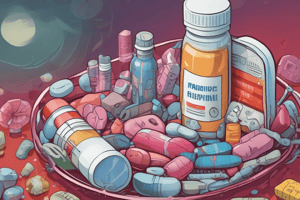Podcast
Questions and Answers
What is the origin of chloramphenicol?
What is the origin of chloramphenicol?
- Synthesized from a plant-based compound
- Man-made antibiotic
- Extracted from a fungus
- Derived from the bacterium Streptomyces venezuelae (correct)
What is the mechanism of action of chloramphenicol?
What is the mechanism of action of chloramphenicol?
- Interfering with DNA replication
- Inhibiting protein synthesis by binding to the 50S ribosomal subunit (correct)
- Disrupting the bacterial cell membrane
- Inhibiting the synthesis of the bacterial cell wall
What is the functional group responsible for the antibacterial activity of chloramphenicol?
What is the functional group responsible for the antibacterial activity of chloramphenicol?
- Nitrobenzene moiety (correct)
- Dichloroacetyl group
- Hydroxyl groups
- Amide group
How many chiral centers are present in the structure of chloramphenicol?
How many chiral centers are present in the structure of chloramphenicol?
What is the configuration of the hydroxyl groups in the threo form of chloramphenicol?
What is the configuration of the hydroxyl groups in the threo form of chloramphenicol?
Which form of chloramphenicol is responsible for its antibacterial activity?
Which form of chloramphenicol is responsible for its antibacterial activity?
What is the starting material for the synthesis of chloramphenicol?
What is the starting material for the synthesis of chloramphenicol?
What is the purpose of the hydrogenation reduction step in the synthesis of chloramphenicol?
What is the purpose of the hydrogenation reduction step in the synthesis of chloramphenicol?
What type of bacteria is chloramphenicol effective against?
What type of bacteria is chloramphenicol effective against?
What is the function of the nitrobenzene moiety in chloramphenicol?
What is the function of the nitrobenzene moiety in chloramphenicol?
How many stereoisomers of chloramphenicol are possible due to its chiral centers?
How many stereoisomers of chloramphenicol are possible due to its chiral centers?
What is the configuration of the hydroxyl groups in the erythro form of chloramphenicol?
What is the configuration of the hydroxyl groups in the erythro form of chloramphenicol?
What is the purpose of the nitration and dichloroacetylation step in the synthesis of chloramphenicol?
What is the purpose of the nitration and dichloroacetylation step in the synthesis of chloramphenicol?
What is the product of Step 2 in the synthesis of chloramphenicol?
What is the product of Step 2 in the synthesis of chloramphenicol?
Why is the threo form of chloramphenicol biologically active?
Why is the threo form of chloramphenicol biologically active?
What type of catalyst is used in Step 1 of the synthesis of chloramphenicol?
What type of catalyst is used in Step 1 of the synthesis of chloramphenicol?
What is the result of reacting -2-nitro-1-benzylcarbinol with formaldehyde in Step 2 of the synthesis?
What is the result of reacting -2-nitro-1-benzylcarbinol with formaldehyde in Step 2 of the synthesis?
What is the importance of stereochemistry in chloramphenicol?
What is the importance of stereochemistry in chloramphenicol?
Flashcards are hidden until you start studying
Study Notes
Chloramphenicol Overview
- Chloramphenicol is a broad-spectrum antibiotic derived from the bacterium Streptomyces venezuelae.
- It exhibits activity against both aerobic and anaerobic Gram-positive and Gram-negative bacteria.
Mechanism of Action
- Chloramphenicol binds reversibly to the 50S ribosomal subunit of bacteria, inhibiting protein synthesis.
Chemical Structure
- Chloramphenicol contains a nitrobenzene moiety and is a derivative of dichloroacetic acid.
- It has two chiral centers, resulting in four possible isomers.
Stereochemistry
- Chloramphenicol has two chiral centers (asymmetric carbons) in its structure, resulting from hydroxyl groups on carbon atoms adjacent to the dichloroacetyl group.
- The chiral centers result in four stereoisomers: Threo-Chloramphenicol and Erythro-Chloramphenicol, each with R or S enantiomers.
Biological Activity
- The threo form (specifically the R-threo enantiomer) is the active form responsible for antibacterial activity.
- The erythro form is inactive.
Synthesis
- Chloramphenicol is synthesized chemically by modifying the nitrobenzene ring of the antibiotic.
- The synthesis begins with p-nitroacetophenone and involves four key steps: synthesizing -2-nitro-1-benzylcarbinol, reacting with formaldehyde, performing hydrogenation reduction, and nitrating and dichloroacetylating the intermediate.
Structure-Activity Relationship (SAR)
- The SAR of chloramphenicol is not explicitly stated in the text.
Chloramphenicol Overview
- Chloramphenicol is a broad-spectrum antibiotic derived from the bacterium Streptomyces venezuelae.
- It exhibits activity against both aerobic and anaerobic Gram-positive and Gram-negative bacteria.
Mechanism of Action
- Chloramphenicol binds reversibly to the 50S ribosomal subunit of bacteria, inhibiting protein synthesis.
Chemical Structure
- Chloramphenicol contains a nitrobenzene moiety and is a derivative of dichloroacetic acid.
- It has two chiral centers, resulting in four possible isomers.
Stereochemistry
- Chloramphenicol has two chiral centers (asymmetric carbons) in its structure, resulting from hydroxyl groups on carbon atoms adjacent to the dichloroacetyl group.
- The chiral centers result in four stereoisomers: Threo-Chloramphenicol and Erythro-Chloramphenicol, each with R or S enantiomers.
Biological Activity
- The threo form (specifically the R-threo enantiomer) is the active form responsible for antibacterial activity.
- The erythro form is inactive.
Synthesis
- Chloramphenicol is synthesized chemically by modifying the nitrobenzene ring of the antibiotic.
- The synthesis begins with p-nitroacetophenone and involves four key steps: synthesizing -2-nitro-1-benzylcarbinol, reacting with formaldehyde, performing hydrogenation reduction, and nitrating and dichloroacetylating the intermediate.
Structure-Activity Relationship (SAR)
- The SAR of chloramphenicol is not explicitly stated in the text.
Studying That Suits You
Use AI to generate personalized quizzes and flashcards to suit your learning preferences.




